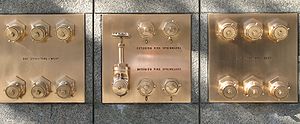
Standpipe
Encyclopedia

Water
Water is a chemical substance with the chemical formula H2O. A water molecule contains one oxygen and two hydrogen atoms connected by covalent bonds. Water is a liquid at ambient conditions, but it often co-exists on Earth with its solid state, ice, and gaseous state . Water also exists in a...
piping
Piping
Within industry, piping is a system of pipes used to convey fluids from one location to another. The engineering discipline of piping design studies the efficient transport of fluid....
which is built into multi-story buildings in a vertical position, to which fire hose
Fire hose
A fire hose is a high-pressure hose used to carry water or other fire retardant to a fire to extinguish it. Outdoors, it is attached either to a fire engine or a fire hydrant. Indoors, it can be permanently attached to a building's standpipe or plumbing system...
s can be connected, allowing manual application of water to the fire. Within buildings standpipes thus serve the same purpose as fire hydrant
Fire hydrant
A fire hydrant , is an active fire protection measure, and a source of water provided in most urban, suburban and rural areas with municipal water service to enable firefighters to tap into the municipal water...
s.
In some countries that follow British methods, such as New Zealand, hydrants
Fire hydrant
A fire hydrant , is an active fire protection measure, and a source of water provided in most urban, suburban and rural areas with municipal water service to enable firefighters to tap into the municipal water...
in streets are below ground and fire trucks carry standpipes, and key and bars on the trucks. The bar is used to lift a cover in the road, exposing the hydrant. The standpipe is then "sunk" into the hydrant and hose is then connected to the exposed ends of the standpipe. The bar is then combined with the key and is used to turn the hydrant on and off.
Dry standpipe
For standpipes fixed into buildings, the pipe is in place permanently with an intake usually located near a road or driveway so that a fire engineFire apparatus
A fire apparatus, fire engine, fire truck, or fire appliance is a vehicle designed to assist in fighting fires by transporting firefighters to the scene and providing them with access to the fire, along with water or other equipment...
can supply water to the system. The standpipe supply pipe extends into the building to fire fighting
Fire fighting
Firefighting is the act of extinguishing fires. A firefighter fights fires to prevent loss of life, and/or destruction of property and the environment...
water to the interior of the structure via hose outlets, often located between each floor in stairwells in high rise buildings. Dry standpipes are not filled with water until needed in fire fighting. Fire fighters often bring hoses in with them and attach them to standpipe outlets located along the pipe throughout the structure.
See also Dry riser
Dry riser
A dry riser is a main vertical pipe intended to distribute water to multiple levels of a building or structure as a component of the fire suppression systems. The pipe is maintained empty of water. The dry riser is the opposite of a "wet riser" or "wet standpipe" system where the pipes are kept...
.
Wet standpipe
A "wet" standpipe is filled with water and is pressurized at all times. In contrast to dry standpipes, which can be used only by firefighters, wet standpipes can be used by building occupants. Wet standpipes generally already come with hoses so that building occupants may fight fires quickly.Advantages
Laying a firehose up a stairwell takes time, and this time is saved by having fixed hose outlets already in place. There is also a tendency for heavy wet hoses to slide downward when placed on an incline (such as the incline seen in a stairwell), whereas standpipes do not move. The use of standpipes keeps stairwells clear and is safer for exiting occupants.Standpipes go in a direct up and down direction rather than looping around the stairwell, greatly reducing the length and thus the loss of water pressure due to friction loss
Friction loss
Friction loss refers to that portion of pressure lost by fluids while moving through a pipe, hose, or other limited space. In mechanical systems such as internal combustion engines, it refers to the power lost overcoming the friction between two moving surfaces.- Causes :Friction loss has several...
. Additionally, standpipes are rigid and do not kink, which can occur when a firehose is improperly laid on a stairwell.
See also
- Fire Equipment Manufacturers' AssociationFire Equipment Manufacturers' Association-History:Founded in 1930, The Fire Equipment Manufacturers’ Association or FEMA is an international, non-profit trade association dedicated to manufacturing commercial fire protection equipment to serve as the first line of defense against fire in its early stages...
- Fire sprinklerFire sprinklerA fire sprinkler system is an active fire protection measure, consisting of a water supply system, providing adequate pressure and flowrate to a water distribution piping system, onto which fire sprinklers are connected...
- Dry riserDry riserA dry riser is a main vertical pipe intended to distribute water to multiple levels of a building or structure as a component of the fire suppression systems. The pipe is maintained empty of water. The dry riser is the opposite of a "wet riser" or "wet standpipe" system where the pipes are kept...
- Siamese connectionSiamese connectionIn fire protection engineering, a Siamese connection is a pipe fitting that allows two fire hoses to be connected to a single standpipe riser at the same general location. It is so-called due to the visual allegory to Siamese twins.-References:...

